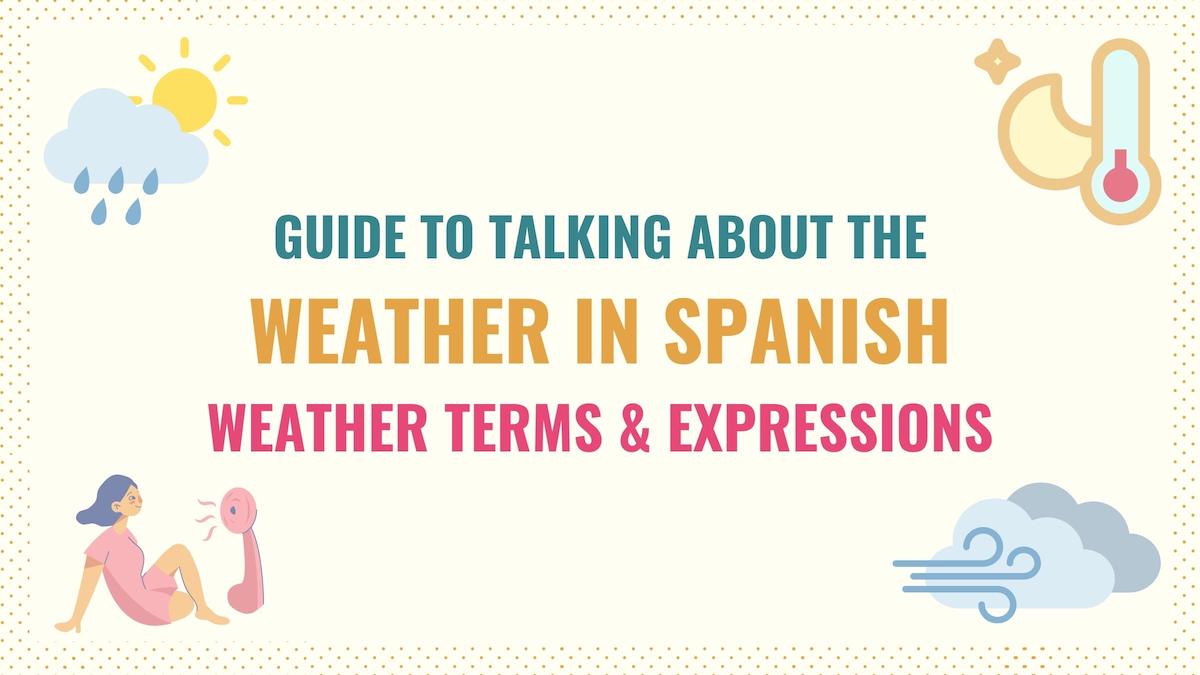No matter what I do, I can never think about good conversation topics when talking to new people. And what do I do? I use the oldest strategy in the book: I talk about the weather 😌! Whether you relate or not, being able to ask or talk about the weather in Spanish is something that you definitely need to know if you want to become fluent in this language.
Let’s forget for a moment about my poor social skills. If you think about it, the weather is one of those topics that people constantly use on a daily basis. For that reason, in this guide, we’ll go over the following topics:
- Different ways to ask about the weather
- Describing the weather
- Weather expressions and vocabulary
- How to talk about the weather in different tenses
- Key points
- Resource for Talking about the Weather in Spanish
Asking About the Weather in Spanish
There are different questions that you can use to ask about the weather. As you may imagine, using these structures depends on the information that you want to obtain. Below are some examples, descriptions and formulas that you can use for this purpose.
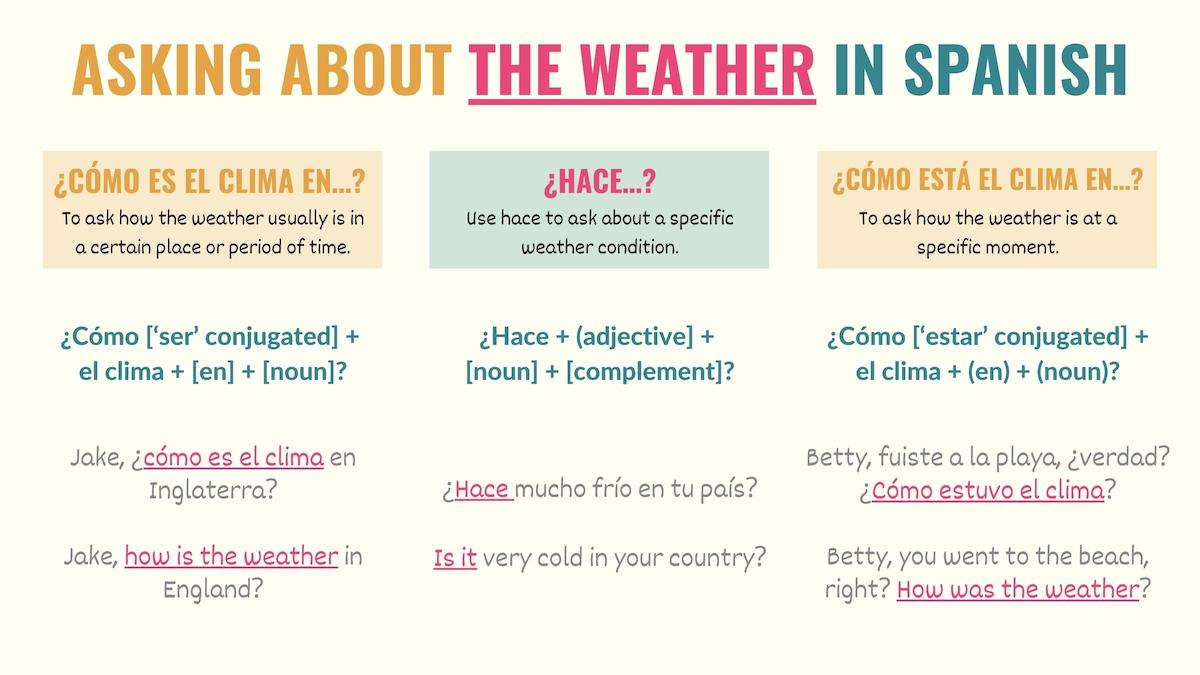
Learning Spanish?
Join the Tell Me In Spanish community and get a copy of my step-by-step Spanish Learner’s Roadmaps and tricky synonyms & vocab cheat sheets.
1. ¿Cómo es el clima en…?
Although this is a very common question, we only use it when asking for a general description about how the weather usually is in a certain place or period of time. Check these examples:
¿Cómo [ser conjugated] + el clima + [en] + [noun]?
Jake, ¿cómo es el clima en Inglaterra?
Jake, how is the weather in England?
Oigan, chicas, en Alemania, ¿cómo es el clima en verano?
Hey, girls, how is the weather in Germany during summer?
2. ¿Hace…?
Use hace to ask about a specific weather condition. Even though it’s such a popular term, keep in mind that it only works with certain words.
¿Hace + (adjective] + [noun] + [complement]?
¿Hace mucho frío en tu país?
Is it very cold in your country?
¿Crees que mañana hará calor otra vez?
Do you think tomorrow will be hot again?
Papá, cuando fuiste a Francia, ¿hacía frío o calor?
Dad, when you went to France, was it cold or warm?
3. ¿Cómo está el clima en…?
You should use this Spanish weather expression any time you want to know how the weather is at a specific moment. As a variation, you can also use the question ¿qué tal está el clima? Check these examples below:
¿Cómo [estar conjugated] + el clima + (en) + (noun)?
Betty, fuiste a la playa, ¿verdad? ¿Cómo estuvo el clima?
Betty, you went to the beach, right? How was the weather?
¿Qué tal ha estado el clima en Cancún?
How has the weather been in Cancun?
Notice that by using estar I’m actually asking about the weather at a specific moment. In simple words, with this question, I don’t want to know how the weather usually is at the beach. I just want to know how it was when Betty was there.
5 Ways to Describe the Weather in Spanish
Talking about the weather also means that you should be able to explain cómo es el tiempo (how the weather is). In the sections below, I’ll show you the 5 most common ways to do this. Make sure you read the descriptions so you choose the best structure for your situation.
Take Note: Tiempo is a more formal word that means weather. Because of this, you’re more likely to hear the term tiempo in news or other formal settings.
Using the verb ‘hacer’ to describe the weather

As you may already know, hace is one of the most common Spanish weather expressions. However, we only use it with certain nouns that allow us to explain the weather conditions that we’re experiencing. These words include:
- Sol – Sunny
- Calor – Hot
- Viento / Aire – Wind
- Frío – Cold
- Fresco – Fresh
Here is the phrase structure that you can use with this verb. Notice that you can use adjectives to provide a more accurate description.
Hacer third person singular + (adjective) + [noun]
En otoño, ya no hace tanto calor.
In autumn, it’s not that hot anymore.
A esta hora siempre hace sol.
It’s always sunny at this time of the day.
Cuando era niña, no hacía tanto calor.
When I was little, it wasn’t this hot.
Ayer hizo muchísimo sol.
Yesterday, it was very sunny.
Take Note: Hace is the impersonal form of the verb hacer. Simply put, when talking about the weather, we always use its third person singular conjugation. Aside from this rule, you can conjugate this verb to any tense that you need.
Using ‘ser’ to describe a place’s climate
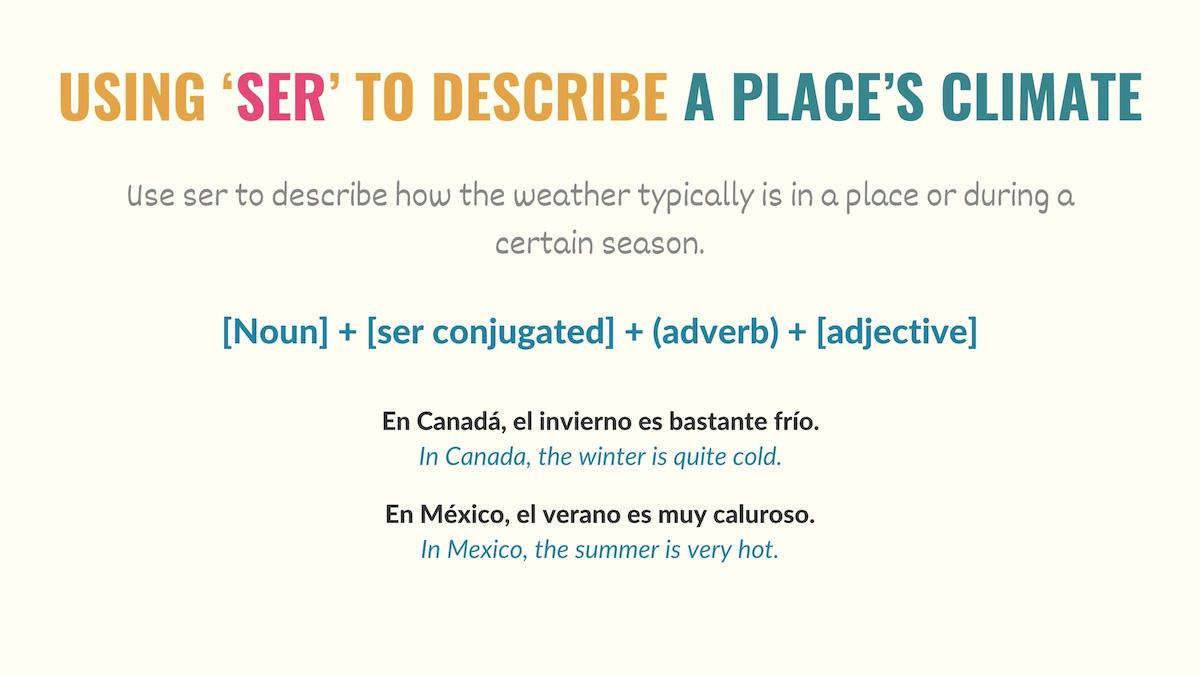
Given that the verb ser is used to talk about the characteristics of something or someone. As a result, we also use it to describe how the weather typically is in a certain place or during a particular period of time.
To put it in simple terms, if I wanted to give you a general description of what you expect about the weather in Mexico, I’ll use ‘ser’.
[Noun] + [‘ser’ conjugated] + (adverb) + [adjective]
En México, el verano es muy caluroso.
In Mexico, the summer is very hot.
El clima es muy agradable en otoño.
The weather is very nice in autumn.
En Canadá, el invierno es bastante frío.
In Canada, the winter is quite cold.
Take Note: When it comes to describing people or things, the verb ‘ser’ can only be used to talk about permanent traits such as physical features or personality.
Using ‘hay’ to talk about the weather

Although you may not be aware of it, hay is another term that you can use to describe the weather in Spanish. Since its core function is to talk about the existence of something, we use this word to talk about the weather phenomena that appears on a certain day. As usual, this word is translated as ‘there is’ or ‘there are’.
Hay + (adj / indefinite article) + [noun]
Hoy hay mucha niebla.
Today, there is a lot of fog.
Hay una tormenta eléctrica en la costa.
There is a lightning storm on the coast.
Mañana estará nublado y habrá mucho viento.
Tomorrow it will be cloudy and there will be a lot of wind.
Using ‘estar’ to describe current weather conditions

In this context, we also use the verb estar to describe or explain what the current weather conditions are at the moment of speaking. Okay, let me rephrase it like a human being. So if I was to tell you how the weather is today or how it has been this past month, I’ll use ‘estar’.
So, depending on the elements that we want to use, we get to choose between two structures.
[‘Estar’ conjugated] + [verb in gerund] + (adj) + (noun)
Hoy está haciendo mucho calor.
Today it’s very hot.
Llévate un paraguas, está lloviendo.
Take an umbrella. It’s raining.
La semana que viene estará nevando muy fuerte.
Next week, it will be snowing very hard.
If instead of a verb in gerund you want to use an adjective, you can use the following structure:
[‘Estar’ conjugated] + (adv) + [adjective]
Ha estado muy nublado toda la semana.
It’s been really cloudy all week.
El clima está muy agradable hoy.
The weather is very nice today.
El día está fresco y con poco sol.
Today is fresh and a bit sunny.
Use weather-related verbs
As you can imagine, another common way that you can use to describe or explain the weather in Spanish is by using weather-related verbs.
En verano, llueve mucho.
During summer, it rains a lot.
La semana pasada, nevó en las montañas.
Last week, it snowed in the mountains.
Llévate un paraguas porque ya se nubló.
Take an umbrella because it got cloudy.
Vocabulary: Words & Weather Expressions in Spanish
Here is a list of popular expressions and vocabulary that you can use to describe or talk about the weather:
- Llover a cántaros: Raining cats and dogs
- Hacer buen tiempo: To have nice weather
- Hacer mal tiempo: To have bad weather
- Hacer un calor de los mil demonios: To be hot as hell
- Hacer un frío que pela: To be freezing cold
- Hacer frío: To be cold
- Hacer calor: To be hot
In addition to these expressions, you can also use the following nouns and adjectives. I’ve added a column so you can see with which verb each word should be used.
| Spanish | English | Works with |
|---|---|---|
| Sol | Sunny | Hace |
| Soleado | Sunny | Estar |
| Frío | Cold | Hace |
| Templado | Warm | Ser / Estar |
| Calor | Hot | Hace |
| Caluroso | Hot / Warm | Ser |
| Nublado | Cloudy | Estar |
| Lluvioso | Rainy | Ser / Estar |
| Niebla | Fog | Hay |
| Relámpago | Lightning | Hay |
| Trueno | Thunder | Hay |
| Granizo | Hail | Hay |
| Nube | Cloud | Hay |
| Húmedo | Humid | Ser |
| Humedad | Humidity | Hay |
| Fresco | Fresh | Hacer / Estar |
| Tormenta | Storm | Hay |
| Seco | Dry | Ser / Estar |
| Luvia | Rain | Hay |
How to talk about weather in the past in Spanish
In order to talk about the weather in the past, you simply need to conjugate the verb that you are using to preterite, imperfect, or any required past tense. Just like any other Spanish verb, verbs that describe the weather can be conjugated to any tense.
Many of my students thought that describing the weather in other tenses rather than the present is very difficult. In reality, this is simpler than you think since you only need to make sure that the verb is conjugated to any tense that you need.
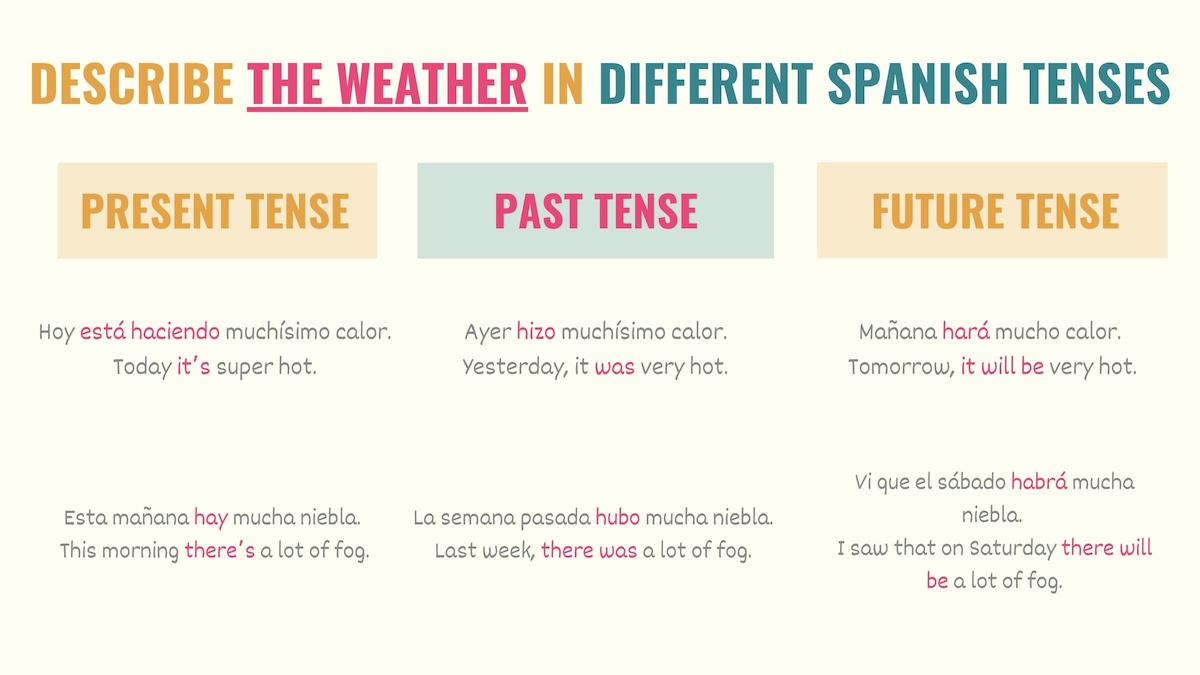
So, as long as you know how to conjugate your verb, you shouldn’t have any issues. Check these examples below:
Present tense
Hoy está haciendo muchísimo calor.
Today it’s super hot.
Esta mañana hay mucha niebla.
This morning there’s a lot of fog.
Past tense
Ayer hizo muchísimo calor.
Yesterday, it was very hot.
La semana pasada hubo mucha niebla.
Last week, there was a lot of fog.
Future tense
Mañana hará mucho calor.
Tomorrow, it will be very hot.
Vi que el sábado habrá mucha niebla.
I saw that on Saturday there will be a lot of fog.
Take Note: When talking about weather forecasting, we either use the verb ‘esperar’ (to expect) or ‘pronosticar’ (to forecast).
Key Points
Being able to talk about the weather in Spanish not only can be an icebreaker topic (for people like me), but it’s also a great opportunity to practice some common (and sometimes kind of confusing) verbs and grammatical structures.
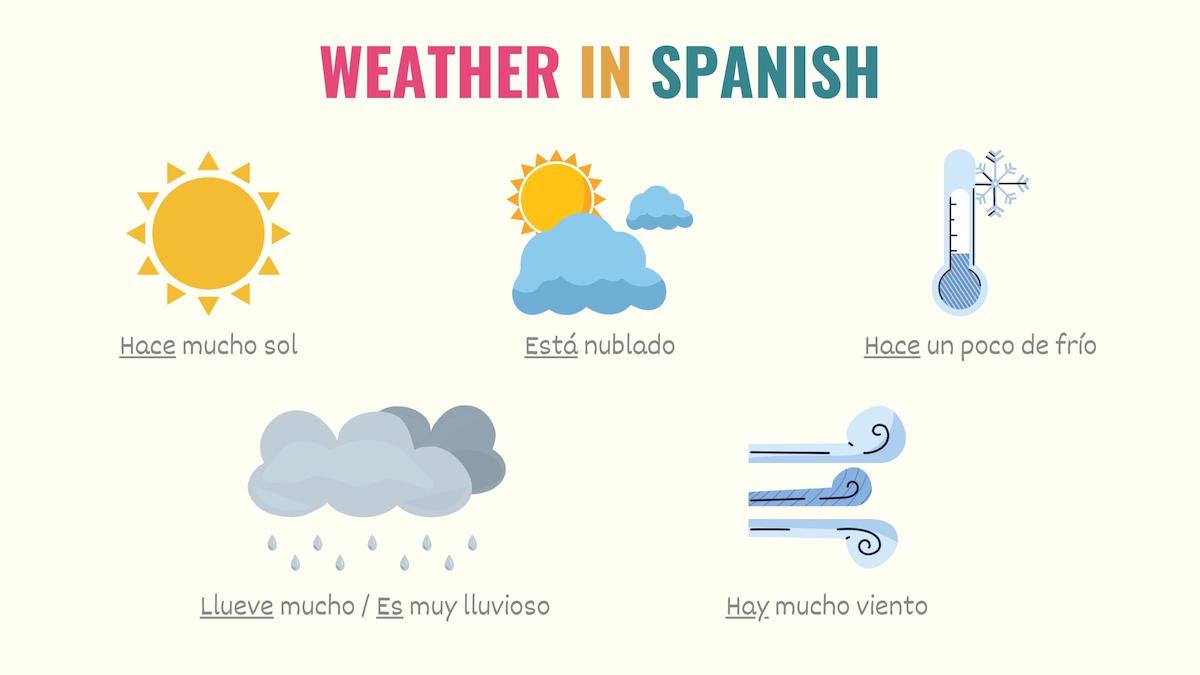
Since we cover a lot of ground, here are some key points that you should keep in mind:
- Ser describes or asks how the weather usually is during a season or in a certain place.
- Hace works with certain nouns to describe or ask about weather conditions and temperatures.
- Estar describes or asks the weather conditions at the moment of speaking.
- Both ‘ser’ and ‘estar’ work with adjectives.
- All of these verbs can be conjugated to any tense to describe the weather at a specific moment in time.
Hopefully, now you’ve become familiar with the weather in Spanish. Now, you have an ace up your sleeve if you don’t have a conversation topic with someone 😉
Spanish Weather Top Resources
There are some related topics you should check to master this topic. For example, you need to understand the difference between calor and caliente. Although they both refer to temperature, you cannot use them interchangeably.
To make your weather descriptions more rich, I recommend you to learn adverbs and adjectives. Finally, make sure you know how to conjugate the basic verbs to ask or describe the weather. Here are some guides:
Download the Spanish Weather PDF Cheat Sheets
Talking about the weather in Spanish is one of the more difficult topics for beginners. This is because we rely on a number of verbs to describe the weather and the various vocabulary needed. I’ve created a PDF you can download for free with all of the key vocabulary and sentence structures from this guide so you can revisit this topic whenever you need.

